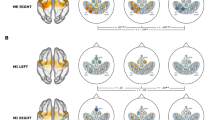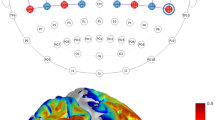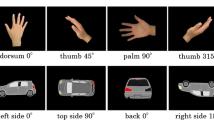Abstract
Introduction
The use of functional magnetic resonance imaging (fMRI) for clinical applications and basic neuroscience is constantly increasing. The discussion about minimum performance requirement for a correct implementation of fMRI is still open, and one of the critical points is the magnetic field strength. We tested the feasibility of fMRI at 1.0 T during motor and cognitive tasks.
Methods
Fourteen healthy subjects were scanned during a motor task and 12 while performing the Tower of London task. In the activated areas, the percentage signal change due to BOLD (blood oxygenation level dependent) contrast was analysed. To check basic image quality of the acquisition system we measured quality indices in a temporal series of images of a phantom.
Results
Motor and cognitive brain activations matched previous results obtained at higher field strengths. The mean percentage change over subjects in the motor task was in the range 1.3–2.6% for the primary motor area and 0.8–6.7% for the cerebellum. In the cognitive task, the mean percentage change over subjects was 0.7–1.2% for a frontal area and 0.6–2.8% for a parietal area. The percentage noise of the phantom temporal series was less than 0.4%. Percentage changes and signal to noise ratio, although lower than that obtained with high-field systems, allowed activation maps to be obtained in all subjects.
Conclusion
Our results replicate previous fMRI results demonstrating reproducible motor-related brain activations and extend the field to a complex cognitive task, thus providing evidence of the safety for routine clinical use of 1-T equipment.





Similar content being viewed by others
References
Kwong KK, Belliveau JW, Chesler DA, Goldberg IE, Weisskoff RM, Poncelet BP, Kennedy DN, Hoppel BE, Cohen MS, Turner R, Cheng HM, Brady TJ, Rosen BR (1992) Dynamic magnetic resonance imaging of human brain activity during primary sensory stimulation. Proc Natl Acad Sci U S A 89:5675–5679
Ogawa S, Tank DW, Menon RS, Ellermann JM, Kim SG, Merkle H, Ugurbil K (1992) Intrinsic signal changes accompanying sensory stimulation: functional brain mapping with magnetic resonance imaging. Proc Natl Acad Sci U S A 89:5951–5955
Bandettini PA, Wong EC, Hinks RS, Tikofsky RS, Hyde JS (1992) Time course EPI of human brain function during task activation. Magn Reson Med 25:390–397
Lovblad KO, Remonda L, Heid O, Schneider J, Gonner F, Schroth G (1999) Clinical single-shot diffusion-weighted MRI of the human brain on a short-bore medium-field imager. Neuroradiology 41:889–894
Santosh CG, Rimmington JE, Best JJK (1995) Functional magnetic resonance imaging at 1T: motor cortex, supplementary motor area and visual cortex activation. Br J Radiol 68:369–374
Lundervold A, Ersland L, Gjesdal KI, Smievoll AI, Tillung T, Sundberg H, Hugdahl K (1995) Functional magnetic resonance imaging of primary visual processing using a 1.0 tesla scanner. Int J Neurosci 81:151–168
Van der Kallen BFW, Van Erning LJTh, Van Zuijlen MWJ, Merx H, Thijssen HOM (1998) Activation of the sensorimotor cortex at 1.0 T: comparison of echo-planar and gradient-echo imaging. AJNR Am J Neuroradiol 19:1099–1104
Papke K, Hellmann T, Renger B, Morgenroth C, Knecht S, Schuierer G, Reimer P (1999) Clinical applications of functional MRI at 1.0 T: motor and language studies in healthy subjects and patients. Eur Radiol 9:211–220
Deblaere K, Boon KA, Vandemaele K, Tieleman A, Vonck K, Vingerhoets G, Backes W, Defreyne L, Achten E (2004) MRI language dominance assessment in epilepsy patients at 1.0 T: region of interest analysis and comparison with intracarotid amytal testing. Neuroradiology 46:413–420
Jones AP, Hughes DG, Brettle DS, Robinson L, Sykes JR, Aziz Q, Hamdy S, Thompson DG, Derbyshire SWG, Chen ACN, Jones AKP (1998) Experiences with functional magnetic resonance imaging at 1 T. Br J Radiol 71:160–166
Noll DC, Cohen JD, Meyer CH, Schneider W (1995) Spiral K-space MR imaging of cortical activation. J Magn Reson Imaging 5:49–56
Andreasen NC, Rezai K, Alliger R, Swayze VW 2nd, Flaum M, Kirchner P, Cohen G, O’Leary DS (1992) Hypofrontality in neuroleptic-naïve patients and in patients with chronic schizophrenia. Assessment with xenon 133 single-photon emission computed tomography and the Tower of London. Arch Gen Psychiatry 49:943–958
Morris RG, Ahmed S, Syed GM, Toone BK (1993) Neural correlates of planning ability: frontal lobe activation during the Tower of London test. Neuropsychologia 31:1367–1378
Baker SC, Rogers RD, Owen AM, Frith CD, Dolan RJ, Frackowiak RS, Robbins TW (1996) Neural system engaged by planning: a PET study of the Tower of London task. Neuropsychologia 34:515–526
Owen AM, Doyon J, Dagher A, Sadikot A, Evans AC (1998) Abnormal basal ganglia outflow in Parkinson’s disease identified with PET. Implications for higher cortical functions. Brain 121:949–965
Dagher A, Owen AM, Boecker H, Brooks DJ (1999) Mapping the network for planning: a correlational PET activation study with the Tower of London task. Brain 122:1973–1987
Rowe JB, Owen AM, Johnsrude IS, Passingham RE (2001) Imaging the mental components of a planning task. Neuropsychologia 39:315–327
Lazeron RH, Rombouts SA, Machielsen WC, Scheltens P, Witter MP, Uylings HB, Barkhof F (2000) Visualizing brain activation during planning: the tower of London test adapted for functional MR imaging. AJNR Am J Neuroradiol 21:1407–1414
Fincham JM, Carter CS, van Veen V, Stenger VA, Anderson JR (2002) Neural mechanisms of planning: a computational analysis using event-related fMRI. Proc Natl Acad Sci U S A 99:3346–3351
Van den Heuvel OA, Groenewegen HJ, Barkhof F, Lazeron RHC, van Dyck R, Veltman DJ (2003) Frontostriatal system in planning complexity: a parametric functional magnetic resonance version of Tower of London task. Neuroimage 18:367–374
Schall U, Johnston P, Lagopoulos J, Jüptner M, Jentzen W, Thienel R, Dittmann-Balçar A, Bender S, Ward PB (2003) Functional brain maps of Tower of London performance: a positron emission tomography and functional magnetic resonance imaging study. Neuroimage 20:1154–1161
Weisskoff RM (1996) Simple measurement of scanner stability for functional NMR imaging of activation in the brain. Magn Reson Med 36:643–645
Simmons A, Moore E, Williams SCR (1999) Quality control for functional magnetic resonance imaging using automated data analysis and Shewhart Charting. Magn Reson Med 41:1274–1278
Price RR, Allison J, Massoth RJ, Clarke GD, Drost DJ (2002) Practical aspects of functional MRI (NMR Task Group #8). Med Phys 29:1892–1912
Parrish TB, Gitelman DR, LaBar KS, Mesulam MM (2000) Impact of signal to noise on functional MRI. Magn Reson Med 44:925–932
Oldfield RC (1971) The assessment and analysis of handedness: the Edinburgh Inventory. Neuropsychologia 9:97–113
Friston KJ, Holmes AP, Worsley KJ, Poline JB, Frith CD, Frackowiak RS (1995) Statistical parametric maps in functional imaging: a general linear approach. Hum Brain Mapp 2:189–210
Worsley KJ, Friston KJ (1995) Analysis of fMRI time-series revisited – again. Neuroimage 2:173–181
Friston KJ, Holmes AP, Worsley KJ (1999) How many subjects constitute a study? Neuroimage 10:1–5
Acknowledgements
This study was supported by grants from both “Compagnia di San Paolo” and “Ricerca Sanitaria Finalizzata 2004 - Regione Piemonte”.
Conflict of interest statement
We declare that we have no conflict of interest.
Author information
Authors and Affiliations
Corresponding author
Additional information
A.B. and O.R. contributed equally to the realization of the study and to the drafting of the paper.
Rights and permissions
About this article
Cite this article
Boghi, A., Rampado, O., Bergui, M. et al. Functional MR study of a motor task and the Tower of London task at 1.0 T. Neuroradiology 48, 763–771 (2006). https://doi.org/10.1007/s00234-006-0119-7
Received:
Accepted:
Published:
Issue Date:
DOI: https://doi.org/10.1007/s00234-006-0119-7




